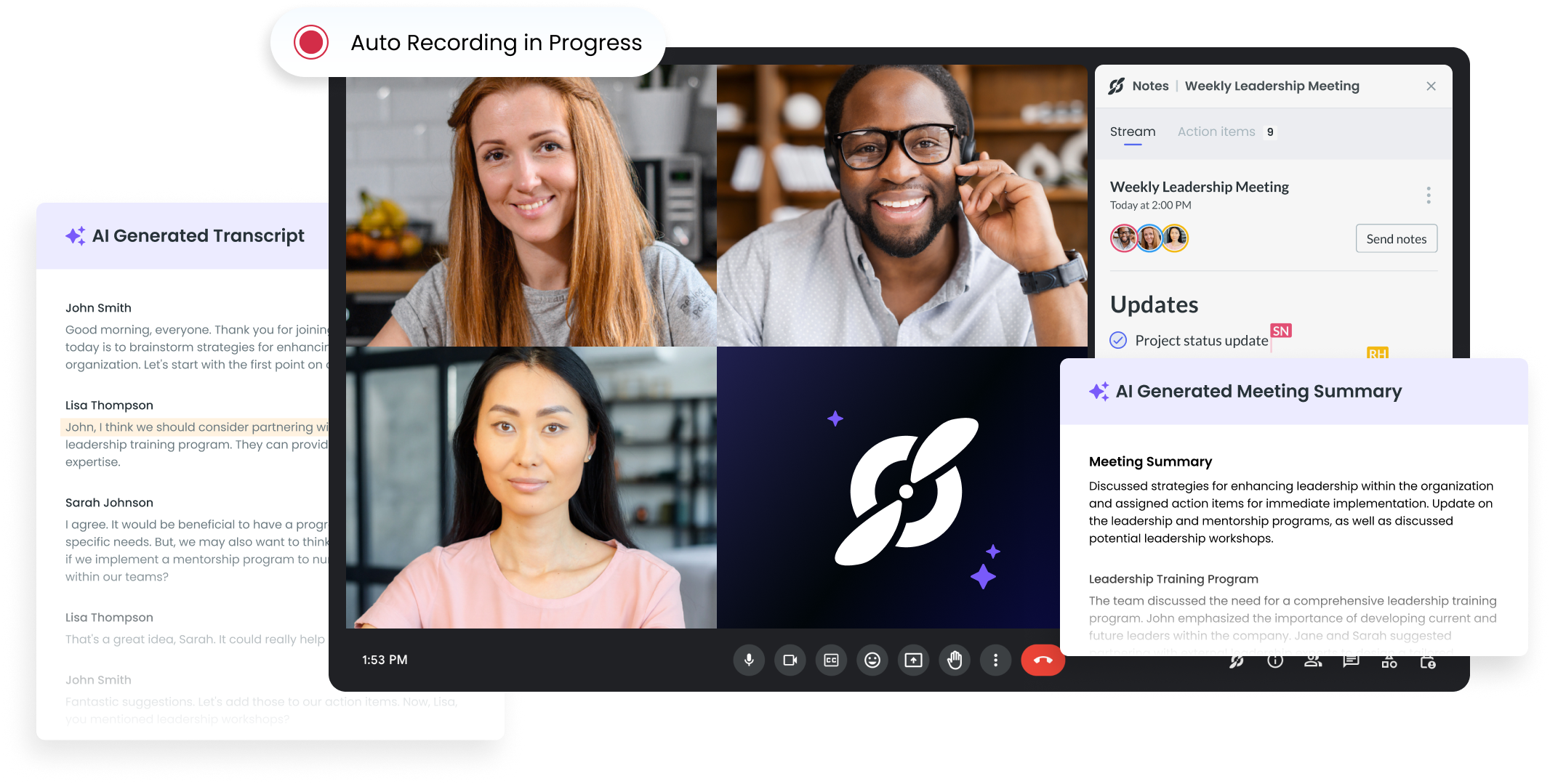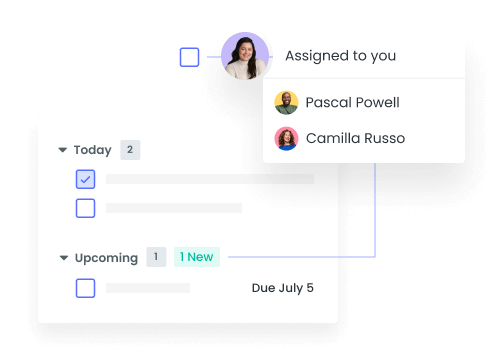
A ‘thank you for the meeting’ email shows your participants that you value their time and keeps the momentum going post-call!
By Alexandria Hewko • December 12, 2023 • 7 min read In this article 7 min read In this article 7 min readHave you ever finished a successful meeting and been unsure what to do next? Following up to say thank you for the meeting by email is a small but fantastic way to show your appreciation for your participants’ time and gives you a natural segue into continuing the conversation after the call. Use these tips below to craft the perfect ‘thank you for the meeting’ email that will allow you to maintain the momentum from your meeting.

Fellow’s AI meeting summaries provide all the key takeaways from your meetings in minutes so you can revisit discussions and align around next steps.

After a meeting, your thank you email should go out within a few hours. If your entire day is blocked with back-to-back meetings, you can make a point of sending the emails for all of your meetings at the end of each day during focus time. It’s ideal to send these notes within the same day as the call so that it’s fresh in your mind. This ensures the other participants feel appreciated for their time and that everyone is aligned on the plan moving forward. In case there was a miscommunication about the next steps, sending your thank you email promptly after the meeting means you’ll catch any issues early and be able to re-adjust plans as needed.
Start by making it really clear what your message is about. In your subject line, clearly add words like “Thank you for the call” or another similar line that quickly demonstrates your appreciation right away. You can also include a mention that you have next steps or a meeting summary that will signal to the recipient to open the email for more information. For example, you can add “Career Plan Details” or “Next Steps for [Project Name].” Remember to keep your subject lines relatively short (under 60 characters).
Since you just had a conversation with the recipient, it’s a good idea to take a friendly yet professional tone in your email. Making it feel natural and like a continued part of the conversation will help them feel inclined to continue collaborating with you. If you’re sending the email to one person from the call—like if you had a one-on-one meeting, for example—you can address the email with their name. If you are sending the email to a larger group (of more than 4 people), it’s better to use a group term like “team” or “everyone.”
Thanking your participants for the meeting should be done in an appreciative tone. Add an extra sentence to recognize specific contributions, such as documents that were prepared in advance, people who got on the call early, high levels of engagement, or extra brainstormed ideas. Showing that you noticed these things makes your meeting participants feel valued and more likely to demonstrate similar contributions in the future.
If you had a challenging conversation with your meeting participants, it’s especially important to use appreciative and positive language to aid in healthy collaboration in the future. Recognize that you discussed a difficult topic and thank them for working through it with you.
Quickly summarize the details of the call with a meeting recap. In Fellow, you can toggle your settings to automatically receive meeting recaps at the end of every call. You’ll receive this in your inbox, Slack, or Microsoft Teams channel, and the recap will include the meeting agenda, talking points, notes, and action items. Copy and paste meeting highlights directly into your ‘thank you for the meeting’ email. Reviewing what has already been discussed is helpful before moving along to the next steps. It’s also helpful to remind participants of details when you’re following up on overdue action items later.
Every meeting should have action items assigned to specific team members with due dates included. If you have a laundry list of action items, you don’t need to rehash them all in your thank you email. However, it is a good idea to highlight major deliverables and point out where participants can view the full to-do list. If you have another meeting planned to continue the conversation or a list of talking points that have gone unanswered, this is a great place to add that information as well. Including this information in your email will help to clarify who is responsible for providing answers, information, or plans for next steps.
With a tool like Fellow, you can clearly assign action items during the meeting and then easily visualize and prioritize your upcoming tasks all in one place afterward. This makes it easy to identify which action items to include in your email’s next steps.

To enable your meeting participants to follow up on the next steps, offer assistance wherever possible. For example, you can remind attendees where to find important documents related to the project, offer to connect them with another stakeholder who might have more information, or take the initiative to plan the next call. It’s a best practice to keep participants informed about timelines as well. Let them know when they can expect follow-up communication from you related to the meeting topic.
Finish your email with a professional sign-off. You can include a closing note such as “Thank you again for a great call today” or “Have a great weekend and looking forward to connecting next week,” for example. If you have an email signature with your name, contact information, and relevant links, make sure it appears in your email as well—it is a small detail that will help round out your ‘thank you for the meeting’ email.
Of course, make sure you proofread and edit your email! Software tools like Grammarly can integrate into your email and check for any spelling, grammar, or syntax errors. Most major email providers like Gmail and Outlook also have built-in editing tools. As a bonus tip, try to hyperlink any links that you’re adding to your email, as it makes it look clean and easier to read! You can also bold, italicize, or underline text that you want to stand out so your participants can quickly skim the content for the main points.
Dear [Name or Group],
Thank you for meeting this [morning/afternoon] to talk about [meeting purpose]. I appreciated that you [meeting contribution from participant], which helped our call flow smoothly.
We covered a lot of ground today, including:
You can find the full summary and recording of our call here: [meeting recap/recording].
As a next step, let’s book a meeting to discuss [topic]. Are you available on [date] at [time]?
Before the next call, I’ll complete [action item], and I’ll need you to complete [action item] please. Here is more information related to [topic] in case it’s helpful for working on [action item]: [additional information].
Please let me know if you have any questions. Looking forward to collaborating on this with you!
[Your email signature]
Constructing a great follow-up email to say thank you after a meeting can be challenging as your audience varies from meeting to meeting. Being understanding of the group’s needs, open to feedback about frequency and style of communication, and specific when assigning deliverables and goals to team members is at the core of any follow-up communication. Leveraging these best practices and other sources on how to write a thank you email will help you stay aligned with your team as much as possible.
Get leadership, productivity and meeting insights.
Fellow is the only all-in-one AI meeting transcription and management software for remote and hybrid organizations. Have fewer, more effective meetings with the help of AI, productivity-driving features, and seamless integrations.
Get Started Free
Alexandria Hewko Last Updated, 12/12/2023Alexandria Hewko, holding a Master's of Digital Transformation & Innovation at the University of Ottawa and a Bachelor's of International Business from Carleton University, brings a rich blend of international marketing, business management, and IT expertise to her writing. Founder of a travel blog in 2018 and an experienced global marketer in the tech and consumer electronics sectors, Alexandria excels at illuminating lesser-discussed topics through compelling storytelling.
Alexandria HewkoAlexandria Hewko, holding a Master's of Digital Transformation & Innovation at the University of Ottawa and a Bachelor's of International Business from Carleton University, brings a rich blend of international marketing, business management, and IT expertise to her writing. Founder of a travel blog in 2018 and an experienced global marketer in the tech and consumer electronics sectors, Alexandria excels at illuminating lesser-discussed topics through compelling storytelling.